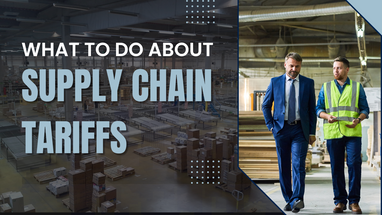Jun 4th 2025
How Tariffs Are Impacting the Automation Supply Chain—and What You Can Do About It
As U.S. manufacturers ramp up their automation efforts to stay competitive, many are facing a familiar but increasingly costly challenge: import tariffs. Whether you’re sourcing collaborative robots, motion control systems, vision sensors, or packaging equipment, evolving tariff schedules—particularly those targeting Chinese imports—can silently erode margins, disrupt timelines, and complicate procurement decisions.
Understanding how tariffs influence the automation supply chain—and how to protect your operations from their downstream impact—is now essential for long-term competitiveness.
What Are Import Tariffs, and Why Do They Affect Automation?
Import tariffs are government-imposed taxes on goods entering the country. In theory, tariffs encourage domestic production and reduce reliance on foreign imports. In practice, however, they often increase costs for businesses that depend on global supply chains.
Section 301 tariffs, first introduced in 2018 and reinforced in the 2025 Harmonized Tariff Schedule (HTS Revision 13), apply significant surcharges to a wide range of automation-related components sourced from China—including robot accessories, electrical enclosures, cable assemblies, pneumatic fittings, and control panels.
Each product is categorized by an HTS code, which determines the tariff rate. For automation parts, rates can reach up to 25% or more.
How Tariffs Disrupt Automation Procurement
Here’s how these tariffs impact companies sourcing automation and robotics components:
-
Increased BOM Costs: Critical components such as robot grippers, linear actuators, sensors, and drives may now carry an additional 10–25% cost, directly affecting your bill of materials and project ROI.
-
Unpredictable Lead Times: Customs delays and reclassification audits can extend delivery timelines—jeopardizing implementation schedules and causing production delays.
-
Vendor Constraints: Some global brands have had to limit product availability or adjust pricing, affecting distributor inventories and end-user access.
Strategies to Offset Tariff-Driven Costs
Forward-thinking companies aren’t just absorbing these costs—they’re adapting:
1. Source from U.S. Distributors with Local Inventory
Working with authorized distributors like Automation Distribution gives you access to in-stock, tariff-mitigated inventory from trusted brands like SMC, Universal Robots, ABB, and Turck—minimizing overseas risk. Automation Distribution keeps stock of thousands of commonly used products. You can see if the items you use are in stock on the individual product pages under "Availability."
2. Shift to Brands with Domestic or Mexico-Based Manufacturing
Brands with North American manufacturing facilities often escape heavy import tariffs. Many of our partners operate U.S.- or Mexico-based production lines, giving you access to HTS-exempt equipment with shorter lead times.
3. Buy Smart—Consolidate Orders and Plan Ahead
Bundle automation components into fewer shipments to reduce per-unit overhead. Our ecommerce platform makes it easy to optimize reorder cycles for maximum savings.
4. Request Tariff Guidance and Component Alternatives
We help customers review part numbers and recommend alternative components that carry lower duty rates or are sourced domestically. It’s not just a quote—it’s a cost-avoidance strategy.
5. Use Total-Cost-of-Ownership (TCO) Models
By factoring in tariff impact, support, shipping, and uptime value, you’ll make better long-term decisions—especially when choosing between imported parts and local alternatives.
How We Help Manufacturers Navigate Tariffs
At Automation Distribution, we don’t just sell automation products—we help you build a smarter supply chain.
-
Over 2 million products online, including domestic and tariff-free options
-
Rapid fulfillment from U.S. warehouses
-
Tariff consulting and part substitution services available
-
Bundled kitting and palletizing automation solutions to lower TCO
-
Ongoing support for scaling automation with cost predictability
Don’t Let Tariffs Stall Your Automation Plans
Tariffs may be here to stay, but your automation progress doesn’t have to slow down. Whether you’re launching a new robotic workcell, upgrading sensors and controls, or rethinking your end-of-line packaging strategy, our team is ready to help you stay on track—and on budget.
Explore our store, request a quote, or contact us directly to audit your automation supply chain and unlock smarter sourcing.

